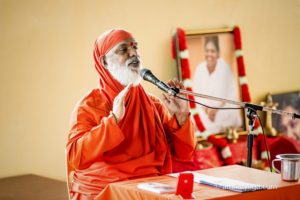Adi Parasakthi – Jnana Sakthi
For the modern youngsters and even many elders, the knowledge of our Puranas (a collection of Hindu scriptures) are based on modern cinema. Most of us know what is Adiparashakthi (divine power) from what we have seen in our cinemas. A movie on Adiparashakthi begins with lightning, thunder, rain, violent storm, planets and galaxies appearing and disappearing and fireworks – like explosions! So this is Parashakthi! Cinema producers, with their limited understanding of our Puranas, highlight only one aspect of Parasakthi. The most important aspect of Jnana Shakthi (divine wisdom) – Mahadevi’s All Knowing aspect is not known to them. We know that the Durga Suktham (a Hindu scripture) starts with Om Jathavedase which means O Devi, the Illuminator and Knower of Everything. In the Sri Suktham (a Hindu scripture) also it says Chandram Hiranmayim Lakshmim Jathavedo ma Avaha. In this line Lakshmi is also called Jathaveda which also means the Illuminator and Knower of Everything.

Some of the devotees were confused when it is said that both good and bad have come from the same source – the Supreme Being. The Guru’s Grace and a deep understanding is required to realise this Truth. In all other religions good and bad are opposite but in our culture, good and bad are relative.
In the Katopanishad, Nachikethas, the seven year old boy asks Yamadeva (the Lord of Death) to teach him about life after death, how a state of deathlessness can be attained. Nachikethas asks
Anyathra Darmaath anyathra Adharmaath
Anyathra asmath kritha akrithath
Anyathra boothaath cha bhavyaath cha
Yath tath pashyasi, tad vada
O Yamadeva, tell me what you know about That which is beyond both Dharma and Adharma, beyond cause and effect and which is beyond past and future – The Ultimate Reality.
In the beginning of our Sadhana we renounce the bad and accept only the good, but in the final stage, we go beyond good also.
Good and bad are relative. Let us examine –
Is it good to chant the Lalitha Sahasranama (the Thousand Names of the Divine Mother)? In one voice, we will say, it is good. Nothing is better than chanting Sahasranama. But, when in our Kali temple hall, Amma had called all ashram residents and was very seriously giving us advice and instructions, one person was busy chanting Sahasranama – it is bad! When our Guru is talking to us, we must be totally focused on our Guru, nothing else is more important. Therefore, what is good at a particular place and time may be bad at another particular place and time.
 Many years ago, as a student, I read Shakespeare saying “There is nothing good or bad in this world, but thinking makes it so!” I was surprised and did not understand it at all! But now, slowly, I am understanding it!
Many years ago, as a student, I read Shakespeare saying “There is nothing good or bad in this world, but thinking makes it so!” I was surprised and did not understand it at all! But now, slowly, I am understanding it!
Here, again, in the Katopanishad, Yamadeva answers Nachiketha’s question
Shreyashcha Preyashcha
Manushyam Ethau……..
Yamadeva says “Two paths lie in front of man, shreyas or the path of the good, and preyas, the path of the pleasant. The wise man chooses the path of the good which leads to Permanent Happiness but the dull headed chooses the path of the pleasant – he prefers accumulation and enjoyment which is impermanent.
The Vedas do not say the good and the bad, but it says the good and the pleasant. Mother Vedas advises us to go beyond both. This pair of opposites are called Dvandva in our Sastras (sacred texts). The best example coming to our minds is the 12th chapter of Bhagavad Geetha – Verse 18,
“Sama shathrau cha mithre cha
Tathaa maana apamaanyoh
Sheetha ushna sukha dukheshu
Sama sanga vivarjithaha”
Bhagavan Krishna says O Arjuna, be equal minded towards enemies and friends, so too in honour and dishonour, so too towards cold and heat and sorrow and enjoyment.”
Bhagavan Krishna teaches us that these pairs of opposites are all impermanent by nature, and advises us to endure them –
“Aagamaapayinah Anithyah
Taamsthithikshasva Bharatha”
“O Arjuna, these pairs of opposites come and go, learn to endure them with equal – mindedness.”
Bhagavan Krishna teaches us in many places in Bhagavad Geetha to go beyond the pairs of opposites, example is chap 2 – verse 45
Nirdvando Nithyasattwastho……
Chap 5 – verse 3
Nirdvando hi Mahabaho…….
Chap 7 – verse 28
Thay Dvandva nirmuktho…..
 The best example here is the opening verse of our Guru sthothram
The best example here is the opening verse of our Guru sthothram
“Brahmanandam, Parama Sukhadam….”
In the second line, it is said
“Dvandvaathitham, Gagana sadrishyam!”
It means that our Guru’s nature is like the sky (space) “Gaganasadrisham” which accommodates everything but is affected by nothing. In the same verse, towards the end it is said
Ekam Nithyam Vimalam achalam,
Sarva dhee sakshi bootham –
(Guru is) One, Permanant, Pure, Immovable and the Witness of all thoughts of the mind…..”
We can compare our Guru again to the Infinite Space which is One, Permanent, Pure, Immovable
“Sarva Dhee Sakshi Bhootham”
I am a witness to all thoughts and emotions which arise in my mind
Example – I am aware of sadness in my mind. Then when Amma calls Me, I become very happy.
I am aware of Happiness in my mind. Amma then asks me “Son, do you know the Devi Stotram…..? I tell Amma, No Amma I do not know.
I am aware of ignorance in my mind. Then Amma teaches me the Stotram.
I am aware of knowledge in my mind I am That Awareness in which Vidya and Avidya arise, exist and finally dissolves.
That Pure Consciousness, the Real I am always there.
 We were discussing about Amma’s question, regarding Devi being both Vidya (correct knowledge) and Avidya (incorrect knowledge) Swarupini (the form of). In the same Sahasranama there are four other names given below indicating Devi’s nature of being both the pair of opposites or beyond the pair of opposites.
We were discussing about Amma’s question, regarding Devi being both Vidya (correct knowledge) and Avidya (incorrect knowledge) Swarupini (the form of). In the same Sahasranama there are four other names given below indicating Devi’s nature of being both the pair of opposites or beyond the pair of opposites.
255 – Dharma Adharma Vivarjithayai Namah
She is who beyond Virtue and Vice
661 – Sad Asad Rupa Dharinyai Namah
She who is both Existence and Non-Existence (Both the inert body and life force are Devi)
680 – Bhava Abhava Vivarjithayai Namah
She who assumes the form of both Changing and Non-Changing
757 – Kshara Akshara Aathmikayai Namah
She who is in the form of both Perishable and Imperishable
If I look at my own person I understand that I am both the changing, perishable body/mind and the changeless imperishable awareness. It is Devi alone to whom belongs both the changing and changeless aspects in me.
Raathri or night is a time when all forms merge into darkness – everything becomes non existent!
When I enter an empty hall and say “there is nobody here!” I AM THERE to know there is nobody here or there is nothing here! Even when everything disappears, that “I” the Awareness is always there! That is the real Navarathri. On all other nights, everything is still, everything exits and there is Nothing. But on these Nava (nine) Rathris (nights), when everything exits into sleep, and nothing exists I learn to remember that I the Awareness always exists as the Illuminator of even Nothingness. That Pure Awareness is Devi or Kali who is Ever Existing – That remembrance is the Real Navarathri. Kali is also called Shmashana Vasini, one who resides in the graveyard. After death, we say nothing exists, but Kali always exists as Pure Awareness, the Chaithanyam.
Navarathri is remembering that Ever Existing Shakthi Chaithanyam within us amidst the Ever changing body, mind and the world around us!
In fact that is the meaning of Amrita (immortal, deathless) also. Everything is Mritha dying, but the Chaithanyam in us is the Deathless Amrita.
Swami Amritageetananda Puri
As always, thoughtful comments are invited and appreciated. Share your reflections with us! See below to leave a comment.

0 Comments